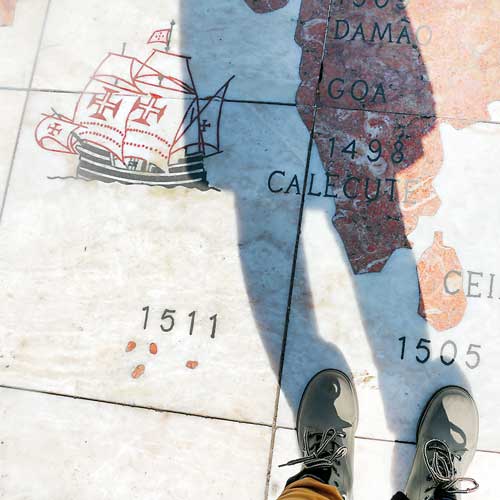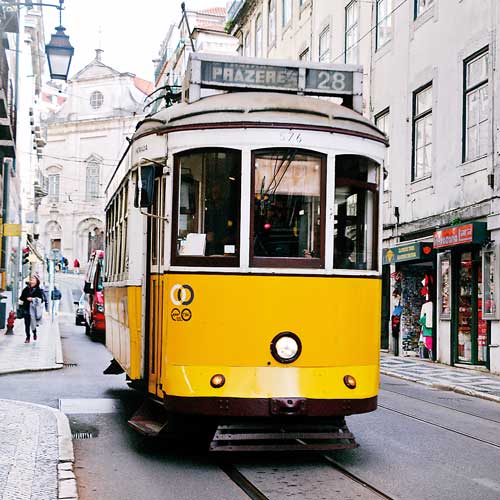Saturday Apr 20, 2024
Saturday Apr 20, 2024
Saturday, 28 January 2017 00:02 - - {{hitsCtrl.values.hits}}
By Aysha Maryam Cassim
Thank you, Lisbon. I wish I had more time to explore the otherworldly charm in you. I will come back soon for Pasteis de Belem, to see the wonders of Castelo de Sintra and enjoy the evening vistas at Miradouro das Portas do Sol.
Portugal is a country which shares a close affinity to my country and its colonial past. Beginning from the 16th century, the European colonial powers made a profound impact on islanders’ lives. When the Dutch ousted the Portuguese in 1658, they left a significant cultural imprint that changed and enriched many spheres of Ceylon.
Lourenço de Almeida was an explorer who made the first Portuguese voyage to Ceylon in 1505. Centuries later, I went to Lisbon to rekindle the bilateral relationship with our fellow ‘parangis’ and reminisce the stories and legends which we learnt in our Social Studies class back in high school.
Lisbon has a lively character that blends well with its antiquated beauty. It’s a pleasant surprise for the first time visitor and a treasure trove for the culturally curious artisans, hipsters and hedonistic thrill-seekers. This historical port city resonates a melancholic aura through its classic yellow vintage trams, colonial facades laced with ‘azuléjos’ and sounds of ‘fado’ echoing through the streets of Alfama.
The ALSA bus departed from Seville, Spain at midnight and reached Lisbon, Portugal in less than six hours. The first thing I did as I landed in the Portuguese Capital was to set my clock one hour back in time. Yes, there is a difference between the two time zones. We didn’t have much time in Lisbon. But we made sure not to miss the best in Belem, Baixa and Alfama districts of Lisbon.
Belem
“Indeed, it was from Belem that Vasco da Gama embarked on his voyage from Portugal to India in 1497, and it was here too that Christopher Columbus anchored on his way back to Spain following his historic discovery of the Americas” – EZPortugal.com.
Lisbon offers some of the best city panoramas in Mediterranean Europe. Head towards Belem to witness some of the famous monuments and a stunning seafront over the estuaries.
Monument to the Discoveries (Padrao dos Descobrimentos)
Located on the banks of the River Tagus in Lisbon stands a mighty structure that dominates the shoreline with grandeur and valour. This iconic monument was erected in 1960 in honour of the great Henry the Navigator, who led Portugal’s discovery expeditions into the New World during the age of great geographical discoveries – the era when Portugal would dominate the sea trade between the continents.
The structure is a reminder of the country’s past glory and the adventurers who helped establish Portugal as a 14th-century superpower. The figure of Henry the Navigator is positioned at the front of the monument on the bow of the ‘ship’, staring out towards the Atlantic Ocean.
I also gravitated towards the pavement in front of the Discoveries Monument to examine the floor, which was adorned with an attractive mosaic map made from rose and grey marble. The map depicts a compass, alongside a map of the world showing the routes that were taken by Portugal’s intrepid explorers and the countries that they colonised.

Mosteiro dos Jerónimos and Torre de Belem
The imposing façade of Mosteiro dos Jerónimos that extends for about 300 metres is a masterpiece that exudes the magnificence of 16th-century Manueline-style architecture (Portuguese late-Gothic). It was classified as a UNESCO World Heritage Site, along with the nearby Tower of Belém, in 1983.
The monastery was founded by King Manuel I to commemorate Vasco da Gama’s expedition and celebrate the successful Portuguese voyages around the world. The “Tower of Belém” was built in 1515 as a fort in the middle of the Tagus River. The structure carries maritime motifs alongside historical figures made from stone. Belem Tower is easily reached via the Avenida de Brasilia and is located close to the Jeronimos Monastery.
Travelling around Lisbon
The transport system in Lisbon is a fascinating network of trams, buses, metro, taxis, tuk-tuks and funiculars interlinking from the city centre to far corners of the quaint old city. We had only 24 hours to explore the treasures of Lisbon and the unlimited 24-hour ticket, which we purchased from one of the kiosks in town, saved our day. This all day travel pass costs less than Euro 8 and can be used for the metro, trams and buses within city limits.
‘Electrico 28’
Your trip to Lisbon is not complete until you aboard the whimsical little yellow tram. The route of tram 28 is picture-perfect. Validate your travel pass and hop on a classic yellow, legendary tram 28, which takes you back in time. This is the best way to explore the city’s well-travelled streets and less-trodden corners.
It takes you to Alfama, navigating along the winding and very narrow streets to town up at sea level. During the day and height of the tourist season, the tram gets notoriously busy with local commuters and tourists, trying to get a glimpse of Lisbon’s most popular tourist sights. Refer to Lisbon’s tram network guide and plan your ride that covers the picturesque attractions of Lisbon, which outlines the five main tram routes.
Praça do Comércio
Lisbon’s monumental riverside square can be found in the downtown Lisbon, Baixa – the heart of the city. ‘The Praça do Comércio’ is where the royal palace stood for over two centuries until it was destroyed by the Great Earthquake which hit the entire Baixa district, in 1755.
It is the banking district that was once where traders and financiers would negotiate, do business transactions and fund perilous expeditions to the far reaches of the known world. The ornate triumphal arch, ‘Arco da Rua Augusta’ marks the entrance to the Rua Augusta from Avenida da Liberdade. A magnificent statue of King José I is positioned in the centre, against the backdrop of baroque buildings.
Today, Praça do Comércio is an appealing tourist sight, lined with neoclassical shopping boulevards, cafés, restaurants, souvenir boutiques and tuk-tuks. The street performers entertain the passers-by by lending a special charm to the area.
Alfama at night
The historical soul of Lisbon lies in Alfama. This place is a mysterious maze. Everywhere you go, there is some unheard story waiting to be unfolded and unearthed. Alfama is Lisbon’s oldest neighbourhood that survived the huge 1755 earthquake. The name comes from the Arabic Al-hamma, meaning “hot fountains” or “baths”.
“As far back as the 5th century, the Alfama was inhabited by the Visigoths, and remnants of a Visigothic town wall remain. But it was the Moors who gave the district its shape and atmosphere. In Moorish times this was an upper-class residential area. After earthquakes brought down many of its mansions (and post-Moorish churches) it reverted to a working-class, fisher-folk quarter. It was one of the few districts to ride out the 1755 earthquake” – Lonely Planet
We ended our stay in Lisbon, drifting effortlessly in the dimly lit alleyways of Alfama, immersing ourselves with layers of history that reminded us its Visigothic roots and Arabic influence. After the sun was set and the chaos was laid to rest, Alfama was imbued with a romantic atmosphere. The old fishing village suddenly howled with an eerie silence that was intermittently interrupted by Fado sounds from the faraway cafés.